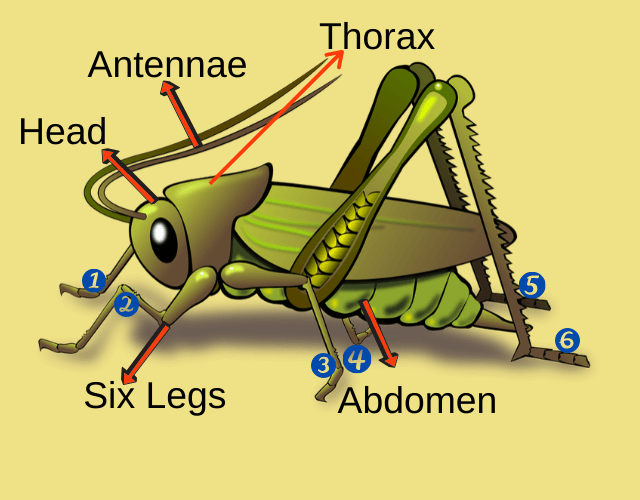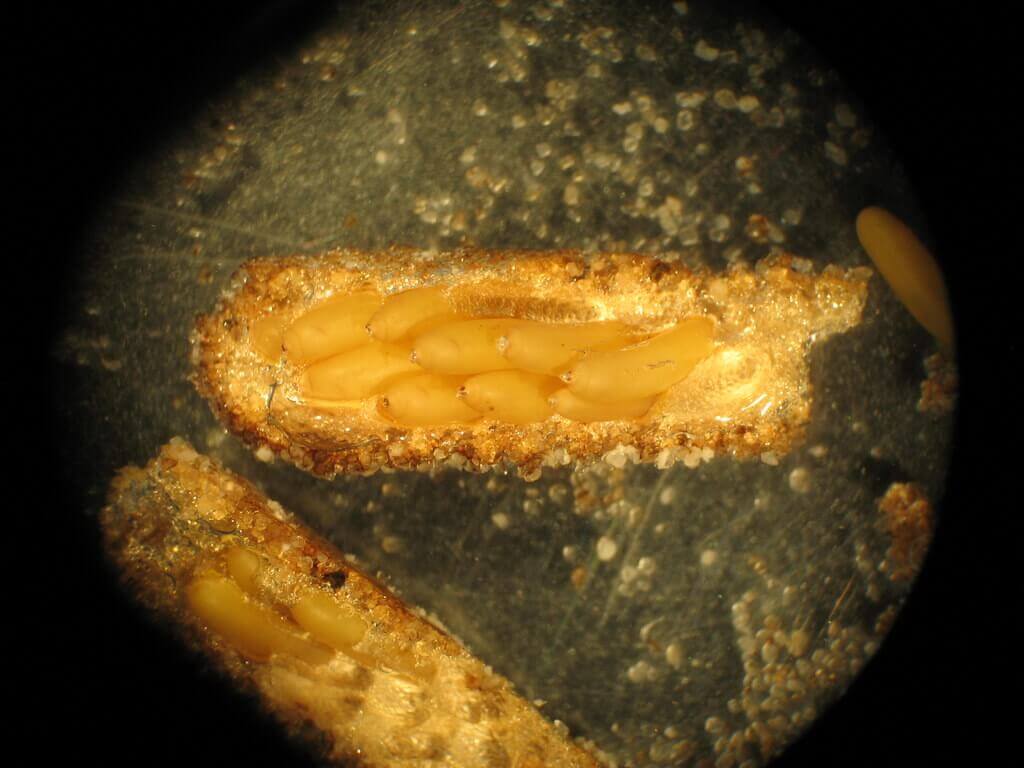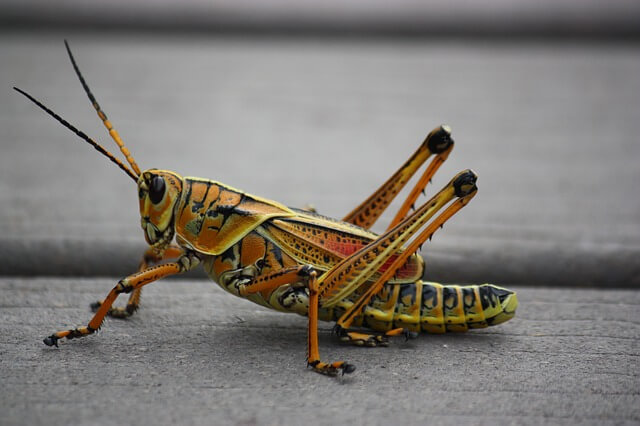The Life Cycle of a Grasshopper
What is the Life Cycle of a Grasshopper?

The life cycle of a Grasshopper is relatively simple. Unlike other insects, the grasshopper’s life cycle consists of THREE stages – the egg, the nymph and the adult.
The life cycle of a grasshopper is known as Incomplete metamorphosis because it consists of THREE stages.
They go through “Incomplete Metamorphosis,” in which each stage looks similar to an adult grasshopper but adds a few changes each time the young grasshopper sheds its skin.
On the other hand, complete metamorphosis has FOUR different stages i.e. the egg, the larva, the pupa and the adult. Examples of complete metamorphosis are butterfly life cycle, frog life cycle etc.
What are the body parts of a Grasshopper?

Grasshopper is an insect from the suborder Caelifera and the order Orthoptera. There are an estimated 11,000 to 20,000 grasshopper species worldwide.
It has mainly THREE parts i.e. the head, the thorax and the abdomen.
The Head – Head contains eyes, antennae, and mouthparts
The Thorax – Thorax contains two pairs of wings and 6 legs
The Abdomen – Abdomen bears the digestive and reproductive structures.
There is also a small part called pinchers used to tear off food such as grasses, leaves and cereal crops.
What is Animal Life Cycle: The life cycle of an animal shows how they grow and change over time.
Life Cycle of a Grasshoppper

What are the 3 Stages of a Grasshopper Life Cycle
Stage 1: Egg

This is the FIRST stage of a grasshopper’s life cycle. The female grasshopper lays fertilized eggs in summer under the sand or in leaf litter. Then she sprays a sticky substance on the egg which hardens and forms a protective waterproof POD around the egg.
Each POD has 10 – 300 eggs inside it, depending on the species. Normally the female grasshopper can lay up to 25 pods.
During autumn and winter season, the eggs remain underneath (under the sand or leaf litters). After TEN months, during summer or spring the eggs hatch and come out as nymph.
Stage 2: The Nymph
Nymphs look like a adult grasshopper without wings and reproductive organs.
During the Nymph stage, it sheds its skin FIVE to SIX times to grow into an adult grasshopper. And this process is known as MOLTING.
To survive, nymphs start to eat succulent and soft plant foliage just after hatching from the egg. This stage of the life cycle lasts for about five to six weeks until it matures to be an adult grasshopper.

Stage 3: The Adult

The adult grasshopper is the THIRD and final stage of life cycle of a grasshopper. It takes about ONE MONTH to develop fully grown wings.
The lifespan of Grasshoppers is about 12 months. At this stage the adult female grasshopper is ready to lay eggs. Once she starts laying eggs, the female grasshopper continues to lay eggs at intervals of three to four days until she dies.
That means when the grasshopper reaches its adult phase it lives for only one or two months.
Summary - THREE Stages of the Life Cycle of a Grasshopper
➤ Stage 1. Egg –
- This is the first stage of a grasshopper’s life cycle.
- After laying eggs, female grasshopper sprays a sticky substance on the egg to form a POD.
- Each POD has 10 – 300 eggs inside it. Normally the female grasshopper can lay up to 25 pods.
➤ Stage 2. Nymph
- Nymphs look like a adult Grasshopper without wings and reproductive organs.
- It sheds its skin five to six times to grow into an adult grasshopper. This process is known as MOULTING.
- It lasts for about five to six weeks until it matures to be an adult grasshopper.
➤ Stage 3. The Adult
- It takes about ONE MONTH to develop fully grown wings.
- Now the adult female grasshopper is ready to lay eggs. She continues to lay eggs at intervals of three to four days until she dies.
- This is the last stage of the life cycle of a grasshopper.
Grasshopper Facts For Kids
➤ FACT 1. There are an estimated 11,000 to 20,000 grasshopper species worldwide.
➤ FACT 2. In many countries, grasshoppers are eaten either as a delicate food or as simply another source of protein.
➤ FACT 3. The large grasshopper can leap 20 times as far as their body length.
➤ FACT 4. They are herbivorous, they eat plants and other types of vegetation.
➤ FACT 5. Grasshoppers Can Devastate Food Crops
➤ FACT 6. The villains in the movie A Bug’s Life by Pixar are grasshoppers.
➤ FACT 7. Female Grasshoppers are usually larger than males. Grasshoppers grow to around 2 inches to 5 inches.
Grasshopper Frequently Asked Questions FAQs
Q. Where do the grasshoppers live??
A. Grasshoppers are found worldwide except Antarctica. Their nature is extremely migratory and go to wherever they find food. There are over 11,000 species of grasshoppers known, about 50 of which are found in Michigan, United States.
Q. How do Grasshoppers hop?
A. Grasshoppers can hop because of their large hind legs that contain large muscles..
Q. What kind of habitat do the grasshopper need?
A. Grasshoppers can live in all climates except the very cold ones. They mostly prefer dry open habitats with lots of grass and other low plants, though some species live in forests.
Q. How do grasshopper communicate with each other?
A. Grasshoppers use their hindlegs and wings to flash visual messages as well as to produce sounds.
Q. What do the grasshopper eat?
A. Grasshoppers are herbivores. They mostly eat leaves, flowers, stems and seeds. Sometimes they also scavenge dead insects for extra protein.
Q. Are Grasshoppers poisonous?
A. They are not poisonous but if a grasshopper is disturbed, they use various chemical defense mechanisms to protect themselves from predators..
Q. What is the difference between grasshoppers and locusts?
A. Locusts and grasshoppers are the same in appearance but differ in the way they behave.
- The front wings of the grasshoppers are thin and rigid while the wings outside are wide and flexible. Whereas locusts have longer and stronger wings to enhance their flight abilities.
- The grasshopper belongs to the suborder known as Caelifera whereas the locust belongs to the suborder Acridida.
- The grasshopper has 28 distinct families while the locust has only 1 family.
- The locust is a type of a grasshopper which is short horned. The grasshopper is not a type of a locust.
Q. What do grasshoppers drink?
A. Grasshoppers get most of the water they need from plants while they are eating.
Hoped you enjoyed about the life cycle of a grasshopper. Reference site for the life cycle of a grasshopper – Here
